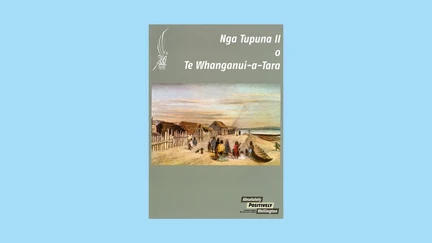Rawiri Matangi, Alive in 1843-1844?
Below is an online version, from Nga Tupuna o Te Whanganui-a-Tara, Volume 2 (2003), of the biography for Rawiri Matangi, reproduced with the kind permission of his whānau.

Published Text
"Rawiri Matangi". In Nga tupuna o Te Whanganui-a-Tara, volume 2. (2003)
Matangi was of the Ngati Te Whiti and Ngati Tawhirikura hapu and also Ngati Hamua and related to Ngati Mutunga. Matangi was also known as Rawiri Matangi Ruhau or Ruahau. He took the name Rawiri after his baptism. He was the son of Te Ua and Mahanga, and grandson of Aniwaniwa and Tawhirikura and thus a cousin of both Te Puni and Wharepouri and closely related to Ngatata and Pomare. His wife was called Pikia Te Rangi and her sister called Tawhirikura Karopihia was the wife of Hemi Parai of Te Aro Pa. Matangi and Pikia had a daughter Kakea Te Rangi and a son Manihera Te Ngatoru.
He was invited to join the heke in 1824 called Te Niho-Puta which Pomare and others brought to Te Whanganui-a-Tara. Te Matangi then returned to Taranaki and came back to Waikanae in 1832 with Te Puni and Wharepouri in Te Heke Tama-te-uaua. While the others remained at Waikanae, Te Matangi and his son Manihera Te Toru came to Petone at the invitation of Te Mana as he was a relation. They lived first at Matiu Island and then built houses at Ngauranga and shared cultivations with Te Mana at that site. Before Pomare left for the Wharekauri (the Chatham Islands) in 1835 he gave Petone and Ngauranga to Matangi while Mohi Ngaponga was given Paekawakawa and Te Aro. Te Matangi and his son were at Ngauranga before Mohi Ngaponga and Hemi Parai came south from Waikanae. After the major migration of Ngati Tama and Ngati Mutunga to Wharekauri in 1835 Wharepouri returned from the Wairarapa to Okiwi and was invited by Te Matangi to settle at Ngauranga. Later when Te Puni returned from the Wairarapa Matangi invited him to settle at Petone. Te Matangi signed the Treaty of Waitangi at Te Whanganui-a-Tara in April 1840. During the negotiations by Major Richmond over the Deeds of Release, Matangi's son Manihera Te Toru refused the payment offered to them for Ngauranga as it was not large enough.
In 1843 Rawiri Matangi sent a sad letter to his daughter at New Plymouth pleading with her not to sell her land as they had done in Te Whanganui-a-Tara.
References:
- Wellington MB no. 1, p.94-96
- Wellington MB no. 1C, p.79
- Wellington MB no. 9 p.178
- Wellington MB no. 11 p.66 - whakapapa
- Otaki MB no. 6 p.53-54
- Ward, Alan. Maori customary interests in the Port Nicholson District 1820s to 1840s : an overview. Wellington : Waitangi Tribunal, 1998.
- Nga Tangata taumata rau : 1769-1869. Wellington : BWB, 1996. p.329
- Nga Waahi taonga o Te Whanganui-a-Tara : Maori Sites Inventory. Wellington : Wellington City Council, 1995.
- M50 Alexander Turnbull Library M.S. Papers 0083-193 Folder 193
(MB = Minute Book)
I Te Reo Māori -
Nō ngā hapū o Ngati Te Whiti, o Ngati Tawhirikura, tae atu hoki ki a Ngati Hamua me Ngati Mutunga a Matangi. I mōhiotia ai hoki a Matangi ko Rawiri Matangi Ruhau ko Ruahau ētahi atu ingoa ōna. Nō tōna iriiringa i huri ai tōna ingoa hei Rawiri. Ko ia nei te tamaiti a Te Ua rāua ko Mahanga, mokopuna ki a Aniwaniwa rāua ko Tawhirikura, nō konā anō e whanaunga ana hoki ki a Te Puni, ki a Wharepouri, ki a Ngatata, ki a Pomare hoki. Ko tana wahine ko Pikia Te Rangi, ā, ko te teina o tana wahine ko Tawhirikura Karopihia hei wahine ki a Hemi Parai, nō te Pā o Te Aro. Ko Kakea Te Rangi te tamāhine a Matangi rāua ko Pikia, ā, ko Manihera Te Ngatoru tā rāua tamaiti.
He mea pōwhiri ia ki te heke Te Niho-Puta i te tau 1824, i aratakina mai e Pomare mā ki Te Whanganui a Tara. Kātahi ka hoki atu Te Matangi ki Taranaki ā, hoki mai anō ki Waikanae i Te Heke Tama-te-uaua, i a Te Puni rāua ko Wharepouri i te tau 1832. Nā te pōwhiri mai a tana whanaunga a Te Mana ka heke mai ai a Te Matangi me tana tamaiti a Manihera Te Toru ki Pito-one, mahue ake ana te iwi ki Waikanae. Ka noho tuatahi ki te moutere o Matiu, ka hanga whare ai ki Ngauranga, ā, noho kāinga ana rātou ko Te Mana ki reira. I mua i te wehenga atu o Pomare ki Wharekauri i te tau 1835 ka kohaina e ia ngā takiwā o Pito-one me Ngauranga ki a Matangi, ā, ki a Mohi Ngaponga ko Paekawakawa me Te Aro. Nō mua atu te noho o Te Matangi me tana tamaiti ki Ngauranga, i te hekenga mai o Mohi Ngaponga rāua ko Hemi Parai i Waikanae. Nō muri i te hekenga nui o Ngati Tama rāua ko Ngati Mutunga ki Wharekauri i te tau 1835, ka hoki mai a Wharepouri i te Wairarapa ki Okiwi, ka pōwhiritia ia e Te Matangi kia noho ki Ngauranga. Nō muri mai ka hoki mai anō a Te Puni i te Wairarapa, ka pōwhiritia ia e Matangi kia noho ki Pito-one. Nā Te Matangi te Tiriti o Waitangi i haina ki Te Whanganui a Tara i te marama o Aperia 1840. I te whakawhitiwhitinga kōrero ki a Major Richmond mō te hoko i te whenua o Ngauranga, kīhai i whakaaea e Manihera Te Toru (te tamaiti a Matangi), nā te tino iti kē o te utu.
Nō te tau 1843 ka tuhi atu a Rawiri Matangi ki tana tamāhine i Ngāmotu, kia kaua e hokona atu ōna whenua, anō ngā whenua i Te Whanganui-a-Tara.